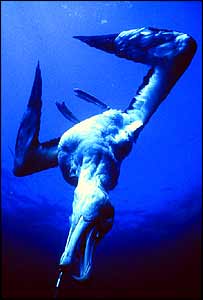ALBATROSSES FACE GROWING PERIL - John Ridgway Save the Albatross
Created | Updated Sep 8, 2003

Press release issued by Royal Society for the Protection of Birds (RSPB), reporting on joint work by BirdLife International and the RSPB
Thursday 4 September, 2003
Longline fisheries heighten albatross extinction fears
A new assessment of albatross populations released today (Friday 5 September) shows that longline fishing is primarily responsible for pushing at least five species of albatross to the brink of global extinction. A disease is also affecting two other species.
The assessment, released by BirdLife International using the latest available population estimates, coincides with an important workshop on seabirds in Cape Town. The work reveals a further alarming decrease in the populations of six of the 21 albatross species, including one species previously regarded as 'safe'. The latest assessment now suggests that all the world's albatrosses are considered to face extinction, largely due to longline fishing. This kills more than 300,000 seabirds, including 100,000 albatrosses annually. The birds either drown or die of their injuries after coming into contact with baited hooks on lines up to 80 miles long.
Dr Euan Dunn, the RSPB's senior marine policy officer, said: "The discovery that all the world's albatross species are now threatened with global extinction is a massive indictment, not just of the indiscriminate fishing practices which are driving these birds to.
Since 2001, BirdLife's Save the Albatross campaign has aimed to reduce the number of seabird deaths caused by the longlining fishing industry to a sustainable level, ensuring that relevant international agreements, such as the Agreement on the Conservation of Albatrosses and Petrels (ACAP), are implemented to benefit both birds and the legal fishing industry.
BirdLife's new research is particularly relevant to ACAP (under the Convention on Migratory Species or Bonn Convention) as the number of countries to ratify this new agreement will soon reach the necessary five for it to enter into force. The agreement requires signatory states to take specific measures to reduce seabird by-catch from longlining and to improve the conservation status of albatrosses and petrels. Australia, Ecuador, New Zealand and Spain have fully ratified, and either South Africa or the UK (unfortunately not covering the UK Overseas Territories where albatrosses breed) will be the next to do so.
At the same time, one of Britain's most experienced sailors, John Ridgway, who rowed the North Atlantic with round-the-world yachtsman Chay Blyth in 1966, is fast approaching South Africa on his year-long expedition by yacht to report illegal fishing operations and campaign for stricter action against them [6]. Ridgway's expedition, with the support of BirdLife International's 'Save the Albatross' campaign, is highlighting the predicament of the Yellow-nosed Albatross en route to Cape Town.
The six species whose threatened status has been significantly
upgraded according to IUCN Red List categories and criteria are:
Black-browed Albatross listed as Near Threatened in 2000 and Vulnerable in 2002, now becomes Endangered, with new census information from the Falkland Islands showing that the species is likely to be declining by more than 50 per cent over three generations (65 years);
Black-footed Albatross, listed as Vulnerable in 2000, now becomes Endangered, with new information and modelling from Hawaii revealing that declines are more serious than previously thought. The species is likely to be declining by more than 50 per cent over three generations (56 years);
Indian Yellow-nosed Albatross, listed as Vulnerable in 2000, also now becomes Endangered with declines being more serious than previously thought, particularly at the stronghold population on Amsterdam Island in the French Southern Territories, and now at more than 50 per cent over three generations (71 years); the disease avian cholera is strongly implicated in this decline.
Laysan Albatross, listed as Least Concern in 2000, now becomes Vulnerable, with new information from the North-western Hawaiian Islands showing declines of at least 30 per cent over three generations (84 years)
Sooty Albatross, listed as Vulnerable in 2000, now becomes Endangered (2003), with new information from breeding islands in the south Atlantic and Indian Oceans showing very serious declines of more than 75 per cent over three generations (90 years).
The most threatened species, the Amsterdam Albatross, already classified as Critically Endangered, is threatened by disease, with the population now reduced to some 20 pairs breeding annually and suffering increasing chick mortality.
Back to the Contents page
